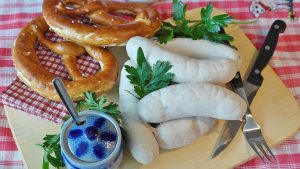
As they are very perishable, Weißwürst traditionally were manufactured early in the morning and prepared and eaten as a snack between breakfast and lunch; there is a saying that the sausages should not be allowed to hear the noon chime of the church bells. Traditionally, Weißwürst may only be served until midday because preservatives are not used, the meat is not smoked, and hence the sausage is made fresh every day. Indeed, they are sometimes called morning sausages. Before modern refrigeration technologies, in summertime the sausages would go bad before nightfall. Even today, most Bavarians never eat Weißwürst after lunchtime (though it is perfectly acceptable to have a lunch consisting of Weißwürst at, say, half past one).
The sausages are heated in water—well short of boiling—for about ten minutes, which will turn them greyish-white because no color-preserving nitrite is used in Weisswurst preparation.
Ingredients:
- 36 g salt
- 600 g lean veal meat (“veal stew meat”) at refrigerator temperature, cut into 1 cm cubes
- 300 g lean pork meat, cut into 1 cm cubes, partially frozen
- 400 g pork fat (pork belly without the skin, etc.) at refrigerator temperature, cut into 1 cm cubes
- 300 g ice
- 100 g pork skin
- ½ tsp dried lemon peel
- ¼ tsp white pepper
- pinch of dried ginger
- pinch of freshly grated cardamom
- pinch of dried mace
- 10 g onion (don’t chop!)
- 20 g parsley, chopped
- sausage casings (hog)
Preparation:
- Prepare casings per instructions (soak in warm water until pliable, rinse outside and inside). Set aside.
- Bring 1 liter of water to a boil. Simmer pork skin and onion for ca. 15 minutes. Remove from water, run through meat grinder, set aside.
- Combine lean meat (pork, veal), spices, salt and half of the ice. Blend in the food processor until you have a smooth mix. Set aside, refrigerate.
- Blend pork fat in the food processor until smooth.
- Blend in lean meat mix.
- Blend in remaining ice until the mixture is smooth and no ice clumps remain.
- With the food processor mix in ground pork skin and parsley, blend just enough to distribute evenly.
- Stuff 16 sausages using a sausage-stuffer or a sausage-stuffing attachment. Do not overstuff, when twisting the links, leave a little room for expansion in each link. If necessary, remove large air bubbles by piercing the casing with a skewer. Tie off the links.
- In a large stock pot heat up water to 80°C. Check with thermometer.
- Place sausages in hot water, leave in for 30 minutes, adjust heat to keep temperature constant at 80°C. Check with thermometer.
- Remove from hot water, place in cold water to cool. Refrigerate until ready to serve.
- To serve, heat up with some fresh parsley in hot beef stock (or salted water). Do not boil or it may cause the sausages to split.
- Serve with fresh pretzels and sweet mustard (“Weißwurstsenf”) and a tall cold glass of Weißbier.
Related Recipes:
German Wurst Guide
German Weißwurst Recipe
Liverwurst
Mettwurst
Classical German Sausage
German Sausage with Apples Sauerkraut and Onion
German Sausage Soup
Strange German Foods Tourists Don’t Understand
